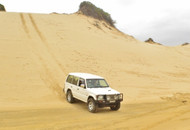The Art of Sand Driving
Published by Peter Harris on 18th Feb 2017
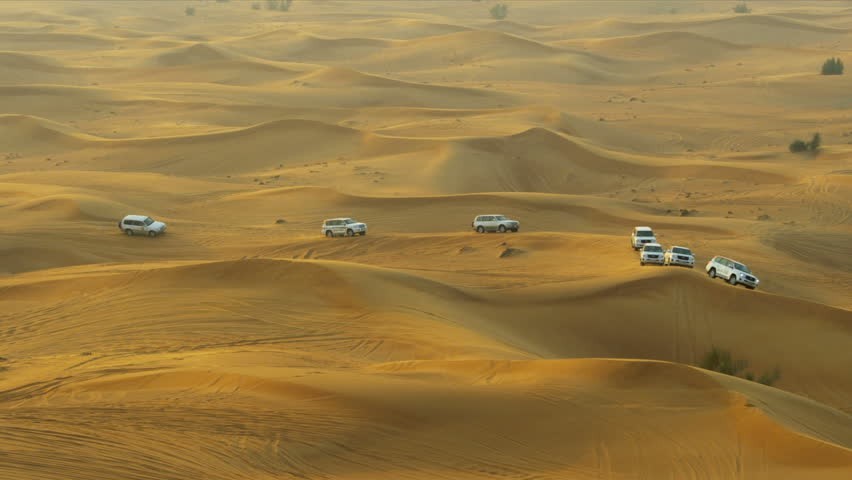 Driving on sand is certainly one of the most exhilarating feelings one can achieve whilst behind the wheel. Gliding from one dune to the other while admiring a vast and empty scenery, oh what a feeling it is! Given the adrenalin rush, one gets from this experience, a lot of us fail to understand the technicalities and basic fundamentals of driving on sand. Although a lot of fun, driving on sand could turn very ugly, very quickly! The danger of driving on the sand when compared to other terrains is the speed factor. Since speeds are usually between 40-50kph, we need to be certain of what is coming next by being able to ‘read’ the sand. Here are a few pointers to make your next sand driving adventure, a much safer one!
Driving on sand is certainly one of the most exhilarating feelings one can achieve whilst behind the wheel. Gliding from one dune to the other while admiring a vast and empty scenery, oh what a feeling it is! Given the adrenalin rush, one gets from this experience, a lot of us fail to understand the technicalities and basic fundamentals of driving on sand. Although a lot of fun, driving on sand could turn very ugly, very quickly! The danger of driving on the sand when compared to other terrains is the speed factor. Since speeds are usually between 40-50kph, we need to be certain of what is coming next by being able to ‘read’ the sand. Here are a few pointers to make your next sand driving adventure, a much safer one!
High Range or Low Range?
The answer to this really depends on the power output of your vehicle, your driving style and the kind of sand you’re driving on. Normally speaking, locked high range will get you through most obstacles in the sand. But sometimes, when the going gets tough, or while recovering another vehicle, it is alright to shift into low range. Staying in low range throughout will increase the risk of throwing too much torque onto the wheels resulting in you getting bogged.
Tyre Pressures
Tyre pressures play key roles in this terrain. Deflating your tyres to about 50% of its recommended pressure will give you increased traction due to the increased surface area coming in contact with the sand. The best way to know if you have deflated enough is to let go of the accelerator while driving and if you come to a gradual and gliding stop, your tyre pressures are fine. If you come to an abrupt stop, you need to deflate further! (To know more about tyre pressures, visit our blog post The 'Go-To Guide' for Tyre Pressures)
No Abrupt Manoeuvres
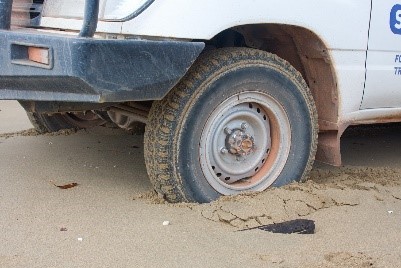 Sand is a very soft surface for your vehicle to cope with. Keeping this in mind, avoid any abrupt manoeuvres. When starting off, don’t burry the gas pedal to the metal. This will end in your tyres spinning out of control, resulting in you being dug inside the sand instead of moving forward. Hitting the brakes too hard will dig your front tyres into the sand which will make it extremely difficult to start again. While driving on sand, it is also important to take note of your turning radius. It is always better to take wider turns in order to keep the tyres from digging themselves into the sand from one side of the vehicle. This could result in rollovers if due care is not given!
Sand is a very soft surface for your vehicle to cope with. Keeping this in mind, avoid any abrupt manoeuvres. When starting off, don’t burry the gas pedal to the metal. This will end in your tyres spinning out of control, resulting in you being dug inside the sand instead of moving forward. Hitting the brakes too hard will dig your front tyres into the sand which will make it extremely difficult to start again. While driving on sand, it is also important to take note of your turning radius. It is always better to take wider turns in order to keep the tyres from digging themselves into the sand from one side of the vehicle. This could result in rollovers if due care is not given!
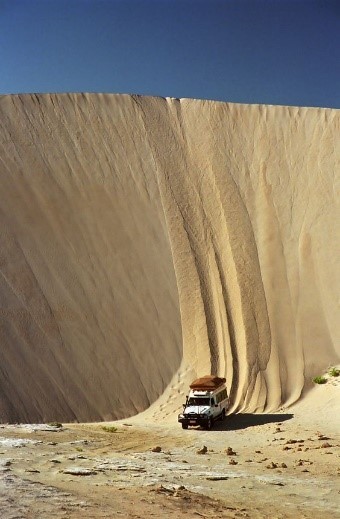
Straight up & Straight Down
Climbing that freakishly tall dune is on all our bucket lists as it comes with a lot of bragging rights! Doing so is absolutely fine, keeping in mind one rule of thumb, straight up and straight down! Obviously there will be instances where going straight up or coming straight down may not be possible, but where possible, stick to heading up straight. This will minimise the risk of getting bogged at dangerous sideways angles or worse, rollovers.
What do I do if I start to lose traction?
If at any time while driving on sand, you feel you are losing traction, STOP! Accelerating harder will only bog you down. The sooner you stop, the easier the recovery will be. Or if you stop soon enough, there might not even be a need for recovery. If you feel you’re losing traction on level ground, you may need to deflate your tyres further. If you lose traction while going up a dune, stop and reverse back in a straight line and try again.
Never Go Alone
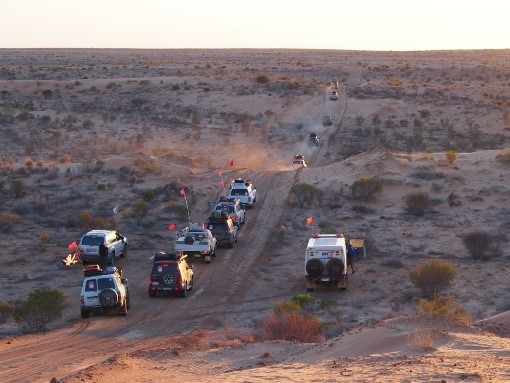 Off-road driving, in general, should never be attempted in a single-vehicle. Always have at least two vehicles going off-road together. This will ensure the presence of at least one recovery vehicle if things were to go south. This rule especially applies to sand driving because of the increased chances of getting bogged.
Off-road driving, in general, should never be attempted in a single-vehicle. Always have at least two vehicles going off-road together. This will ensure the presence of at least one recovery vehicle if things were to go south. This rule especially applies to sand driving because of the increased chances of getting bogged.
Sand Flags
Due to the nature of this terrain, it is impossible to see what is coming up the dune on the other side. Thus to avoid accidents, it is best to increase your visibility by installing bright sand flags. This way, if there is another person climbing the same dune from the other side, he/she will have a lot more time to react as you will be spotted earlier.
Recovery Equipment
Always carry your own recovery kit when you are off-road, whether it be in sand or any other terrain. If you are unable to find yourself a full recovery kit, at the bare minimum, you should have at least two shackles and a snatch strap. This is important because if one vehicle gets stuck without any recovery gear on board, it will be virtually impossible for anyone else to pull you out.
Keeping the above in mind, and practising good driving behaviour will ensure that your next visit to the beach or the desert is a memorable one! (In a good way, of course!)
For a comprehensive guide of driving in different circumstances such as fog, wind, storms etc, we found a great article that will teach you how to drive safely in any circumstances
Stay tuned for more off-road learning!
-Sujay Vasist, All Four x 4 Spares Researcher & Content Writer
Image Sources
https://www.shutterstock.com/video/clip-5300696-stock-footage-professional-tourism-companies-driving-people-in-off-road-vehicles-across-sand-dunes-dubai-desert.html
https://practicalmotoring.com.au/car-advice/reader-help-what-tyre-pressures-should-i-run-for-my-toyota-lc200/
https://au.pinterest.com/pin/542472717593437049/
http://desertchallenge.org/portfolio-view/driving-in-sand-inexperienced-drivers/

